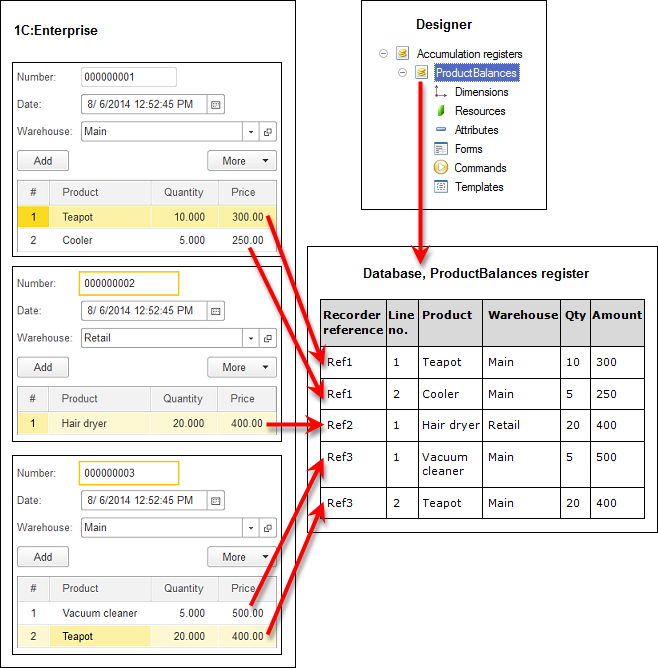The Accumulation register configuration object is intended to describe the data accumulation structure. The platform uses the Accumulation register configuration object as the basis for the creation of database tables that accumulate data provided by various database objects.
This data is stored in the tables as individual records. All of the records have identical structure, which is specified in the Designer (fig. 6.2).

Fig. 6.2. The Product balances accumulation register in Designer and in the database
Based on the accumulation register table of register records, the platform calculates the table of register totals that stores the totals for the time of the last register record in the database (the current totals).
The accumulation register distinctive feature is that it is not designed to be edited directly by users.
The developer might allow users to edit the accumulation register if required. However, the purpose of the accumulation register is to be modified based on modifications of other database objects, rather than through direct user intervention.
The main accumulation register purpose is accumulating numeric data in multiple dimensions, which are declared by the developer in the Accumulation register object. Dimensions are configuration objects that are subordinate to the accumulation register.
The types of numeric data stored in an accumulation register are referred to as resources. Resources are also configuration objects that are subordinate to the Accumulation register object, they are declared in Designer.
For example, an accumulation register can accumulate data on the quantity and the total number of products in the warehouses. In this scenario it will have the Product and Warehouse dimensions and the Quantity and Total resources (see fig. 6.2).
Changes to the accumulation register generally occur when a document is posted, usually this adds a certain number of records. Each record contains the dimension values, incremented values for the resources, a link to the document that caused the change (the recorder) and the "direction" of the increment (receipt or expense). This set of records is referred to as register records of an accumulation register. A recorder is an Infobase object (normally a document) that causes a register record. Each register record has a recorder.
An accumulation register can also contain additional data that describes each register record. The structure of this additional data is specified by the developer using the attributes of the Accumulation register configuration object.
Learn more! For details on the structure of 1C:Enterprise script objects intended for accumulation register operations, see section Quick developer reference. Accumulation registers.
Next page: Adding an accumulation register

